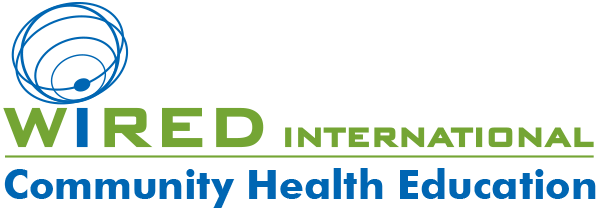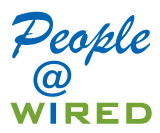 WiRED International editor Allison Kozicharow recently interviewed Maryam Othman, M.D., M.P.H. In addition to teaching at Western University of Health Sciences in California, she is also a WiRED Governing Board member. As you will learn, her commitment to WiRED is a remarkable act of volunteerism and a reflection of her lifelong service to global health.
WiRED International editor Allison Kozicharow recently interviewed Maryam Othman, M.D., M.P.H. In addition to teaching at Western University of Health Sciences in California, she is also a WiRED Governing Board member. As you will learn, her commitment to WiRED is a remarkable act of volunteerism and a reflection of her lifelong service to global health.
Q: Congratulations on your recent promotion to full professor at Western University of Health Sciences! But first, can you talk about your early life and education in Iraq?
A: Thank you. Being promoted to full professorship is both an incredible honor and a deeply meaningful milestone that reflects a journey rooted in my early life and medical education in Iraq. Graduating from the University of Baghdad, College of Medicine in 2000, I carried with me a strong foundation of resilience, purpose and commitment to service. This promotion is not only a recognition of professional growth across continents but also a tribute to the path I’ve walked, from the lecture halls of Baghdad to mentoring the next generation of physicians in California, guided always by a passion for medicine, teaching and research.
Q: What made you decide to go to medical school? What was your experience like at the University of Baghdad?
A: Growing up in Iraq, I witnessed firsthand how critical access to compassionate and skilled medical care was, especially during times of conflicts, sanction and instability. Medicine offered not only the opportunity to help individuals heal but also to serve communities in profound ways. That calling, combined with a strong interest in science and service, made the choice to attend medical school a natural one.
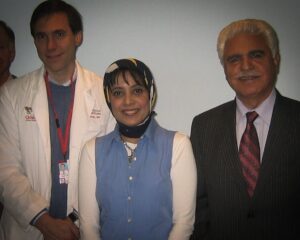
The education and training at the College of Medicine in Baghdad was demanding, grounded in a strong clinical and academic foundation, and taught us to practice medicine with resilience, resourcefulness and empathy, often under very challenging circumstances and lack of resources. Despite the political and social upheavals of the time, the faculty’s dedication and the camaraderie among students instilled in me a lifelong commitment to excellence and service. That experience has stayed with me throughout my career, shaping how I practice, and teach today.
Q: In 2003, after the war, Iraq was undergoing reconstruction of their core facilities, especially medical infrastructure. Iraqi doctors had been isolated during the conflict. How did you meet WiRED Executive Director Gary Selnow and get involved with telemedicine and WiRED?
A: In 2003, after the war, Iraq was facing an urgent need to rebuild its core infrastructure, and the healthcare system was among the most affected. Hospitals, clinics and educational institutions were struggling, and Iraqi doctors, many of whom had been isolated during years of conflict and sanctions, had limited access to up-to-date medical knowledge and international collaboration. As a young physician navigating this landscape, I felt both the weight of these challenges and the responsibility to be part of the solution.
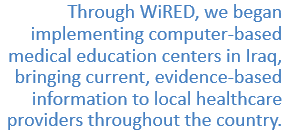 It was during this pivotal time that I was introduced to Dr. Gary Selnow and WiRED . Gary had a vision to bridge the educational gap in post-war settings using telemedicine and digital learning tools. Through WiRED, we began implementing computer-based medical education centers in Iraq, bringing current, evidence-based information to local healthcare providers throughout the country. I became involved in helping to establish these centers and expand access to critical educational resources.
It was during this pivotal time that I was introduced to Dr. Gary Selnow and WiRED . Gary had a vision to bridge the educational gap in post-war settings using telemedicine and digital learning tools. Through WiRED, we began implementing computer-based medical education centers in Iraq, bringing current, evidence-based information to local healthcare providers throughout the country. I became involved in helping to establish these centers and expand access to critical educational resources.
Our work wasn’t just about technology; it was about restoring connection and continuity to a medical community that had been cut off from the world. That experience shaped my understanding of global health, medical education and the power of collaboration. It also helped lay the foundation for my ongoing commitment to innovation in education and equitable access to medical knowledge.
Q: You are not only on WiRED’s Board, but you are Director of WiRED’s Medical Education, which means that you guide any new WiRED module through the process from start to finish. What are your responsibilities and what is your approach?
A: As Director of Medical Education at WiRED, I oversee the development of new medical and health educational modules, from the initial concept to the final. My approach is rooted in these principles: a commitment to accessibility, cultural sensitivity, clinical relevance and evidence-based knowledge. Most of the communities we serve operate in resource-limited settings, so our modules must be evidence-based and easily adaptable to local needs. At the same time, and as equally important, is staying current with evolving medical knowledge and best practices, so I regularly review global health guidelines and work to update our materials accordingly. Ultimately, our goal is to empower healthcare providers and community health workers with the tools they need to deliver better care, no matter where they are in the world.
Q: You have been a leader in developing WiRED’s Community Health Worker (CHW) and Continuing Medical Education (CME) programs. Can you tell me how these projects have evolved and why they are important?
A: WiRED’s CHW training program is built on the idea that education is a powerful equalizer. By providing high-quality, free and accessible training, we’re helping to reduce health disparities and improve access to care and health outcomes globally. WiRED’s CHW training and CME programs have evolved from simple beginnings into a comprehensive, structured curriculum designed to address health needs for basic health services in poor-resourced communities, where professional healthcare providers are scarce.
 I’ve had the privilege of participating in the development of the training program, shaping it into tools that not only provide knowledge but also build long-term capacity. We created a modular, standardized training curriculum and made sure the content is clinically relevant, evidence-based and aligned with international standards. Modules cover everything from chronic disease management to emerging infectious diseases, which equip local CHWs with essential knowledge in prevention, early diagnosis and basic treatment. These individuals often become the first point of contact for health care in their communities. The CME program allows CHWs to stay current and maintain high standards of care, even in isolated regions. That’s what makes this work not only important but deeply meaningful. Seeing how empowered and effective they become with proper training has been incredibly rewarding.
I’ve had the privilege of participating in the development of the training program, shaping it into tools that not only provide knowledge but also build long-term capacity. We created a modular, standardized training curriculum and made sure the content is clinically relevant, evidence-based and aligned with international standards. Modules cover everything from chronic disease management to emerging infectious diseases, which equip local CHWs with essential knowledge in prevention, early diagnosis and basic treatment. These individuals often become the first point of contact for health care in their communities. The CME program allows CHWs to stay current and maintain high standards of care, even in isolated regions. That’s what makes this work not only important but deeply meaningful. Seeing how empowered and effective they become with proper training has been incredibly rewarding.
Q: You have co-written journal articles over the years (2020, 2021, 2022 and 2025) with Dr. Selnow and/or others. Why are these kinds of articles on health valuable?
A: Publishing peer-reviewed journal articles is an essential part of advancing global health work, especially in the context of underserved and low-resource communities. Over the years, I’ve had the opportunity to co-author several articles with Gary and other colleagues, focusing on topics such as community health education, the role of telemedicine, and the impact of training programs for community health workers and clinicians.
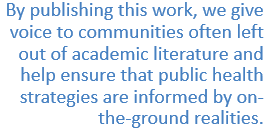 These kinds of publications are valuable for several reasons. First, they help document and validate the work we do, providing evidence that community-based education programs, when thoughtfully developed and implemented, can lead to measurable improvements in health knowledge and outcomes. Second, they contribute to the global conversation on best practices in public health, offering scalable, adaptable models for similar efforts in other regions. These articles bridge the gap between fieldwork and academia. They allow us to share lessons learned, challenges faced and innovations developed in real-world settings, insights that may not always be visible from traditional clinical environments. By publishing this work, we give voice to communities often left out of academic literature and help ensure that public health strategies are informed by on-the-ground realities. These articles serve as a platform for transparency and collaboration, and they play a vital role in helping us continuously improve and expand our efforts.
These kinds of publications are valuable for several reasons. First, they help document and validate the work we do, providing evidence that community-based education programs, when thoughtfully developed and implemented, can lead to measurable improvements in health knowledge and outcomes. Second, they contribute to the global conversation on best practices in public health, offering scalable, adaptable models for similar efforts in other regions. These articles bridge the gap between fieldwork and academia. They allow us to share lessons learned, challenges faced and innovations developed in real-world settings, insights that may not always be visible from traditional clinical environments. By publishing this work, we give voice to communities often left out of academic literature and help ensure that public health strategies are informed by on-the-ground realities. These articles serve as a platform for transparency and collaboration, and they play a vital role in helping us continuously improve and expand our efforts.
Q: What made you decide to pursue an M.P.H. in global health management at George Washington University? Was that part of your winning a Fulbright scholarship?
A: Pursuing a master’s in public health degree in Global Health Management at George Washington University was a natural extension of the work I had already been doing in Iraq and through WiRED. After years of practicing medicine in a post-conflict environment and contributing to community health education initiatives, I realized that improving health outcomes on a broader scale required more than clinical expertise, it required a deep understanding of health systems, leadership, and policy.
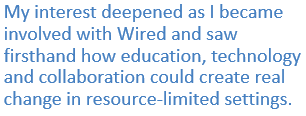 Being awarded a Fulbright scholarship gave me the opportunity to take that next step. It wasn’t just an academic achievement, it was a chance to gain the tools and global perspective I needed to help rebuild and strengthen healthcare infrastructure, especially in underserved regions. The program at George Washington University provided exactly what I was looking for: a strong foundation in global health leadership, strategic planning and systems thinking. The Fulbright experience also reinforced the importance of cross-cultural exchange and collaboration. I was able to learn from colleagues from around the world, share Iraq’s healthcare challenges and successes and gain a knowledge that continues to shape my work today. It was a transformative experience, both professionally and personally.
Being awarded a Fulbright scholarship gave me the opportunity to take that next step. It wasn’t just an academic achievement, it was a chance to gain the tools and global perspective I needed to help rebuild and strengthen healthcare infrastructure, especially in underserved regions. The program at George Washington University provided exactly what I was looking for: a strong foundation in global health leadership, strategic planning and systems thinking. The Fulbright experience also reinforced the importance of cross-cultural exchange and collaboration. I was able to learn from colleagues from around the world, share Iraq’s healthcare challenges and successes and gain a knowledge that continues to shape my work today. It was a transformative experience, both professionally and personally.
Q: Have you always had an interest in global health?
A: Yes, I’ve always had an interest in global health, even before I fully understood the term. Growing up and training in Iraq, I witnessed how health systems are shaped not just by medicine but by politics and economics and how they’re impacted by conflict. I saw the disparities in access to care, the consequences of under-resourced infrastructure and the resilience of communities trying to heal and rebuild. Those early experiences made it clear to me that improving health outcomes required looking beyond the bedside and thinking about broader systems and populations.
 My interest deepened as I became involved with Wired and saw firsthand how education, technology and collaboration could create real change in resource-limited settings. Over time, global health evolved from an interest into a calling, something that continues to shape my work, whether I’m designing medical education programs, training healthcare workers or mentoring the next generation of physicians. It’s not just about addressing health issues across borders; it’s about dignity and the belief that everyone deserves access to quality care, no matter where they live.
My interest deepened as I became involved with Wired and saw firsthand how education, technology and collaboration could create real change in resource-limited settings. Over time, global health evolved from an interest into a calling, something that continues to shape my work, whether I’m designing medical education programs, training healthcare workers or mentoring the next generation of physicians. It’s not just about addressing health issues across borders; it’s about dignity and the belief that everyone deserves access to quality care, no matter where they live.
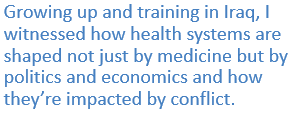 One moment that really crystallized my interest in global health happened shortly after the 2003 war in Iraq. I was working in a hospital that had been severely affected, limited supplies, no reliable electricity, and staff stretched to their limits. One day, a young boy came in with a condition that would have been easily treated in a well-equipped facility. But we didn’t have the necessary resources, and, despite our best efforts, he didn’t survive. That experience left a lasting mark on me, not only because of the loss itself but because I realized how much of it could have been prevented with better systems, training and access to information. Around that same time, I began working with Wired and saw how technology and education could bridge some of these gaps, even in unstable environments. That’s when I understood that my role as a doctor wasn’t confined to treating patients: I had a responsibility to think bigger, to address the systemic challenges that were costing lives every day. That moment helped shift my focus from individual care to population-level impact. It was the beginning of my path toward public and global health.
One moment that really crystallized my interest in global health happened shortly after the 2003 war in Iraq. I was working in a hospital that had been severely affected, limited supplies, no reliable electricity, and staff stretched to their limits. One day, a young boy came in with a condition that would have been easily treated in a well-equipped facility. But we didn’t have the necessary resources, and, despite our best efforts, he didn’t survive. That experience left a lasting mark on me, not only because of the loss itself but because I realized how much of it could have been prevented with better systems, training and access to information. Around that same time, I began working with Wired and saw how technology and education could bridge some of these gaps, even in unstable environments. That’s when I understood that my role as a doctor wasn’t confined to treating patients: I had a responsibility to think bigger, to address the systemic challenges that were costing lives every day. That moment helped shift my focus from individual care to population-level impact. It was the beginning of my path toward public and global health.
Q: At Western University, you are billed as Director, Division of Global and Community Health.
A: My official title at WesternU is:
Professor of Global Health, Office of Medical Education
Chief, Section of Global Health, Department of Population Health Science
Western University of Health Sciences, College of Osteopathic Medicine of the Pacific
Pomona, California
Adjunct Professor, Claremont Graduate University, School of Community and Global Health, Claremont, California
Q: Tell us about the courses and the students you teach at WesternU.
A: At WesternU, I teach a range of topics that focus on population health and global health. My teaching is centered on helping students understand not only the scientific foundations of health and disease but also the social determinants of health — factors such as socioeconomic conditions, education, political structures and environmental stresses — that influence health outcomes around the world. Examples of topics I’ve taught include global population health and health systems and policy as well as specialized topics such as humanitarian health response, maternal and child health and global burden of diseases. I try to make my teaching as interactive and applied as possible, often incorporating case studies, and insights from my experiences in Iraq and with WiRED . My goal is to help our medical students connect theory to practice and prepare them to think critically and act compassionately as future health professionals and leaders.
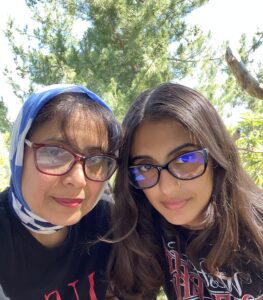
Our WesternU students come from diverse cultures and academic backgrounds, and many of them are deeply motivated to make a difference in their communities or on a global scale. What I enjoy most is seeing how engaged they are with real-world challenges. They bring thoughtful questions, creative ideas and a strong sense of social responsibility to the classroom.
Q: The last I heard of your daughter, Juhainah, was years ago when she was selling Girl Scout cookies. Can you bring us up to date on your family and activities outside WiRED?
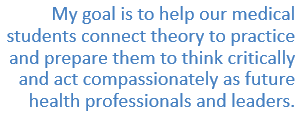 A: She’s still a Girl Scout (a Senior now) and still selling cookies and doing many hours of community service. It’s hard to believe how quickly time has passed; she’s now in high school, thriving academically and exploring her own interests in writing and community service, which, of course, makes me a very proud mother. She’s actually planning on having her Gold Award project for Girl Scouts (that’s due in two to three years) with WiRED (I have not told Gary yet), but she wants to come up with a project related to global health education. Juhainah has grown into a thoughtful, driven young woman. Watching her develop her own voice and passions has been one of the greatest joys of my life.
A: She’s still a Girl Scout (a Senior now) and still selling cookies and doing many hours of community service. It’s hard to believe how quickly time has passed; she’s now in high school, thriving academically and exploring her own interests in writing and community service, which, of course, makes me a very proud mother. She’s actually planning on having her Gold Award project for Girl Scouts (that’s due in two to three years) with WiRED (I have not told Gary yet), but she wants to come up with a project related to global health education. Juhainah has grown into a thoughtful, driven young woman. Watching her develop her own voice and passions has been one of the greatest joys of my life.
Outside of my work with WiRED and my academic roles, I make a strong effort to maintain balance and spend meaningful time with my family. Family has always been a central part of my life, and they continue to inspire and support me in everything I do. They remind me why this work matters, not just professionally but personally.
Archives: Adapted from WiRED’s History Archives
How WiRED and Dr. Maryam Othman Met in Iraq
Adapted from WiRED’s History
A year after I arrived in Iraq, I met Dr. Maryam Othman, a primary care physician working with the Iraqi Ministry of Health and the International Organization for Migration (IOM). WiRED collaborated with IOM in Iraq, which is how I met Maryam. With her help and connections with hospitals, we were able to put programs in place much faster than if I had painstakingly forged new relationships at each facility.
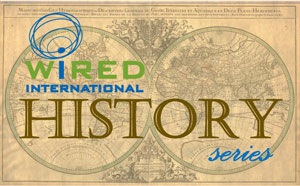 One of Maryam’s responsibilities with IOM was to accompany ailing children from Iraq to Jordan, where they could receive advanced care for life-threatening illnesses. The trip through western Iraq—part of the Syrian Desert known as Al Anbar province—from Baghdad to Amman was long and difficult, made increasingly so by violence that arose in Fallujah and Ramadi and then spread throughout the western portion of the country.
One of Maryam’s responsibilities with IOM was to accompany ailing children from Iraq to Jordan, where they could receive advanced care for life-threatening illnesses. The trip through western Iraq—part of the Syrian Desert known as Al Anbar province—from Baghdad to Amman was long and difficult, made increasingly so by violence that arose in Fallujah and Ramadi and then spread throughout the western portion of the country.
On one occasion, Maryam planned to visit Amman for a series of meetings, and I hitched a ride to work on an unrelated project at the King Hussein Cancer Center. We hired a small van, a driver, and a bodyguard who, it turns out, didn’t have a gun; not that it would have mattered. Fallujah is a little more than an hour out of Baghdad, and that’s exactly how long it took for our van to break down, leaving us stranded on the side of the desert road within sight of Fallujah. With no mobile phone or radio communication, the bodyguard left to hitchhike back to Baghdad for another vehicle.
As bad luck would have it, an American convoy heading toward Baghdad passed us and was promptly attacked by insurgents; a gunfight ensued. Meanwhile, Maryam, the driver, and I sat quietly in the sweltering van, unable to drive away or flee into the desert. This becomes a long story, but the shortened version is that, after the battle ended, the convoy continued on to Baghdad, the insurgents dispersed into Fallujah, and we were eventually picked up by another van. In due time, we made our way to Amman. In Iraq, even a simple day trip could quickly become a tribulation. I recall that through all of this, Maryam was calm and unflappable. She had been through the trying Sadam years and now faced ever-growing challenges with the arrival of American forces to the country.
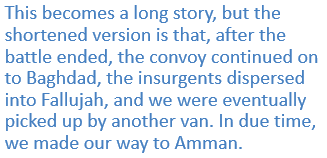 Maryam, like many other physicians in Iraq, faced escalating threats. Her car window was shot out while she was driving, and one day, insurgents came to her home, put a gun to her face, and gave her 24 hours to leave the country. Recognizing this was a real and serious threat, Maryam and her family fled to Dubai the very next day. She was among thousands of physicians forced to abandon Iraq or face a tragic fate.
Maryam, like many other physicians in Iraq, faced escalating threats. Her car window was shot out while she was driving, and one day, insurgents came to her home, put a gun to her face, and gave her 24 hours to leave the country. Recognizing this was a real and serious threat, Maryam and her family fled to Dubai the very next day. She was among thousands of physicians forced to abandon Iraq or face a tragic fate.
I deeply admire Maryam for her commitment and courage in Iraq, particularly her work with us, a small NGO dedicated to bringing medical education tools to the Iraqi medical community. Now in the United States, her contributions as our medical coordinator over the past two decades have been remarkable. Maryam is a skilled educator and humanitarian, and she continues to help WiRED provide an expanding array of educational resources to the world’s most impoverished regions.
–Gary Selnow
https://www.itnhealth.net/wired_archive/WiREDs_Work_in_Iraq_Part_2.html

